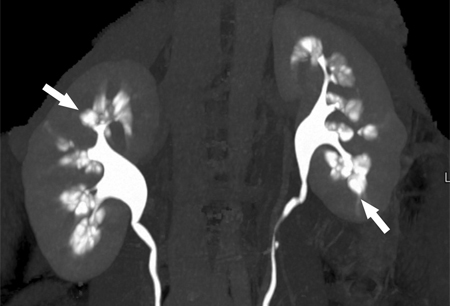Tests
1st tests to order
urinalysis
Test
Microscopic hematuria may be seen.
Pyuria is seen with urinary tract infection (UTI).
Urine pH may be alkaline with distal renal tubular acidosis (dRTA) or struvite stones (magnesium ammonium phosphate) associated with UTI.
Urine pH ≥6.3 and a normal anion gap metabolic acidosis is diagnostic for distal renal tubular acidosis.
Result
may be normal; dipstick positive for leukocytes, nitrates, blood; microscopic analysis positive for WBCs, red blood cells, or bacteria; alkaline pH
urine culture
Test
Properly collected clean-catch urine specimens can be cultured to identify causative agents and determine microbial sensitivity.
Specificity and sensitivity is high.
Result
positive or may be sterile
BUN and creatinine
Test
Patients may rarely have elevated BUN and serum creatinine from obstructive stones or recurrent pyelonephritis.
Result
elevated if estimated glomerular filtration rate is reduced
serum electrolytes
Test
Including calcium, chloride, potassium, phosphate, magnesium, phosphorus, and uric acid.
Result
may be normal or abnormal
abdominal radiography
Test
May be ordered for nonspecific abdominal pain.
Less sensitive and less specific than intravenous urography, but is inexpensive and fast and requires less radiation. In a patient known to have previous radiopaque stones seen on plain radiograph, it is a diagnostic test of good predictive value.
May show nephrocalcinosis in ≥1 papillae; also, renal stones may be observed in the calyces, pelvis, or ureter.[2]
Result
medullary calcification may be present or absent
renal ultrasound
Test
May be ordered for nonspecific abdominal pain, or if urinary tract obstruction is suspected.
Not as sensitive as intravenous urography for MSK.[12]
Result
papillary densities observed irrespective of presence of medullary calcification; a tetrad of ultrasonographic characteristics support a diagnosis of medullary sponge kidney (MSK): hypoechoic medullary areas; hyperechoic spots; microcystic dilatation of papillary zone; and multiple calcifications (linear, small stones or calcified intracystic sediment) in each papilla
intravenous urography
Test
Ordered if medullary sponge kidney (MSK) suspected.
Changes are diagnostic for MSK.
Has for the most part been replaced by noncontrast CT scan (the new diagnostic standard) for evaluation and diagnosis of renal stones.
Typically, most have bilateral involvement, although may be limited to a single papilla.
Study quality and radiologist interpretation affect sensitivity and specificity.
Result
discrete linear papillary densities ("papillary blush" or "paintbrush" pattern); medullary nephrocalcinosis may be present or absent
noncontrast CT scan
Test
Test of choice for kidney stones.
Not as sensitive as intravenous urography for medullary sponge kidney.
Result
medullary calcification may present or absent
CT urogram
Test
Urologists order this test for hematuria, which may incidentally diagnose medullary sponge kidney.[31]
Multidetector-row CT scan is performed with intravenous contrast media. It provides images of contrast-filled renal collecting systems, ureters, and bladder.[32][Figure caption and citation for the preceding image starts]: Computed tomography (CT) urogram showing papillary blush with calculi within dilated collecting tubules (arrows)From Maw AM, et al. Am J Kidney Dis. 2007 Jul;50(1):146-50, with permission [Citation ends].
Result
calcification may be seen within urinary tract
Tests to consider
24-hour urine monitoring
Test
Used in recurrent renal stone patients to determine underlying metabolic causes or etiologies for nephrolithiasis.
Urine parameters evaluated include: volume, pH, calcium, oxalate, citrate, uric acid, phosphate, sodium, potassium, magnesium, ammonium, chloride, sulfate or urea nitrogen, and creatinine. Supersaturations for stone-forming crystals are calculated.
Patients with recurrent renal stones should have subsequent periodic 24-hour urine monitoring or after dietary or medication modifications.
Nephrocalcinosis was reported in 15% of stone formers with medullary sponge kidney (MSK) and 3% of stone formers without MSK.[11]
Result
increased or decreased values for urinary risk factors
stone analysis
Test
Provides information on chemical composition and etiology.
Stones are analyzed after extraction during surgery or after being expelled by patient.
Should be done by x-ray crystallography or infra-red spectroscopy, not by chemical analysis.
Result
stone composition
Use of this content is subject to our disclaimer